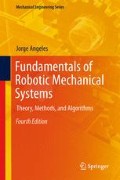Abstract
The purpose of this chapter is to lay down the foundations of the kinetostatics and dynamics of rigid bodies, as needed in the study of multibody mechanical systems. With this background, we study the kinetostatics and dynamics of robotic manipulators of the serial
Access this chapter
Tax calculation will be finalised at checkout
Purchases are for personal use only
Notes
- 1.
A body undergoes a pure translation when all its points move under the same displacement.
- 2.
Smoothness means that they do not introduce jump discontinuities upon differentiation.
- 3.
See Exercise 3.17.
References
Angeles, J., 1988, Rational Kinematics, Springer-Verlag, New York.
Bondy, M., Krishnasamy, R. Crymble, D. and Jasiobedzki, P., 2007, “Space vision marker system (SVMS),” AIAA SPACE 2007 Conference & Exposition, September 18–20, Long Beach, CA.
Brand, L., 1965, Advanced Calculus, John Wiley & Sons, New York.
Ceccarelli, M., 1995, “Screw axis defined by Giulio Mozzi in 1763”, Proc. Ninth World Congress on the Theory of Machines and Mechanisms, August 29–September 2, Milan, vol. 4, pp. 3187–3190.
Chasles, M., 1830, “Notes sur les propriétés générales de deux corps semblables entr’eux et placés d’une manière quelconque dans l’espace, et sur le déplacement fini ou infiniment petit d’un corps solide libre”, Bull. Sci. Math. Ferrusaac 14, pp. 321–326.
Coriolis, G.G., 1835. “Mémoire sur les équations du mouvement relatif des systèmes des corps”, J.Ecole Polytechnique 15, cahier 24, pp. 142–154.
Everett, J.D., 1875, “On a new method in statics and kinematics”, Messenger of Mathematics 45, pp. 36–37.
Mozzi, G., 1763, Discorso Matematico Sopra il Rotamento Momentaneo dei Corpi, Stamperia di Donato Campo, Naples.
Phillips J., 1990, Freedom in Machinery. Vol 2: Screw Theory Exemplified, Cambridge University Press, Cambridge.
Pottmann, H. and Wallner, J., 2001, Computational Line Geometry, Springer, Berlin-Heidelberg-New York.
Roth, B., 1984, “Screws, motors, and wrenches that cannot be bought in a hardware store”, in Brady, M., and Paul, R.P. (editors), Robotics Research. The First International Symposium, The MIT Press, Cambridge, MA, pp. 679–693.
von Mises, R., 1924, “Motorrechnung, ein neues Hilfsmittel der Mechanik”, Z. Angewandte Mathematik und Mechanik 4, no. 2, pp. 155–181.
von Mises, R., 1996, “Motor calculus. A new theoretical device for mechanics”, translated from the German by J. E. Baker and K. Wohlhart, Institute for Mechanics, Technical University of Graz, Graz.
Author information
Authors and Affiliations
Rights and permissions
Copyright information
© 2014 Springer International Publishing Switzerland
About this chapter
Cite this chapter
Angeles, J. (2014). Fundamentals of Rigid-Body Mechanics. In: Fundamentals of Robotic Mechanical Systems. Mechanical Engineering Series, vol 124. Springer, Cham. https://doi.org/10.1007/978-3-319-01851-5_3
Download citation
DOI: https://doi.org/10.1007/978-3-319-01851-5_3
Publisher Name: Springer, Cham
Print ISBN: 978-3-319-01850-8
Online ISBN: 978-3-319-01851-5
eBook Packages: EngineeringEngineering (R0)

